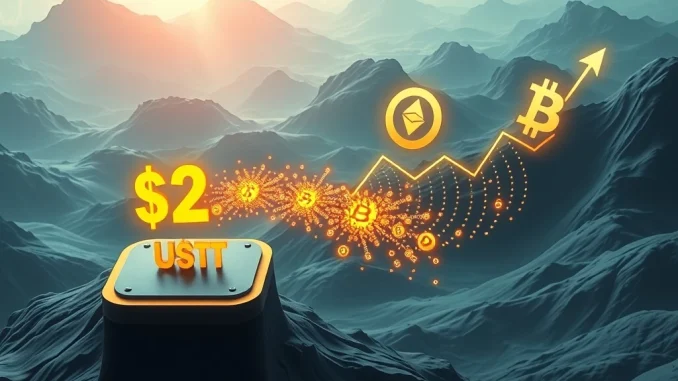
The cryptocurrency world is buzzing with the latest development: Tether Limited has just issued a staggering $2 billion in USDT stablecoins. What makes this particular event crucial for those following Bitcoin news and the wider market? Approximately half of these newly minted tokens have reportedly been transferred to Binance, one of the world’s largest cryptocurrency exchanges. This significant movement has ignited widespread speculation and renewed concerns about potential ripple effects on the broader crypto landscape, particularly for Bitcoin (BTC) and Ethereum (ETH).
Understanding the Crucial Tether USDT Issuance
Tether’s USDT is the largest stablecoin by market capitalization, designed to maintain a peg to the U.S. dollar. Its role as a primary liquidity provider in the crypto ecosystem means that large issuances often catch the market’s attention. This latest $2 billion injection is no exception. However, it’s essential to understand Tether’s operational nuances.
According to Paolo Ardoino, Tether’s Chief Technology Officer, this transaction is characterized as “authorized but not issued.” What does this mean in practice? It implies that the tokens are currently held as inventory within Tether’s treasury. They are not immediately released into the open market but are reserved for future allocation, including:
- Chain Swaps: Moving USDT from one blockchain network to another to meet demand on specific chains.
- Issuance Requests: Fulfilling large-scale purchase requests from institutional clients or exchanges.
- Inventory Management: Maintaining a healthy supply to quickly respond to market demand without delays.
This practice is a standard part of Tether’s supply chain management. It allows the company to maintain control over its stablecoin supply, ensuring it can meet market needs efficiently while avoiding immediate, uncontrolled liquidity injections. While these tokens are not yet in open circulation, their mere presence in Tether’s inventory, especially when earmarked for exchanges, can indirectly influence market dynamics by signaling potential future liquidity.
The Impact of Binance Transfer on Crypto Market Volatility
The fact that approximately $1 billion of this new Tether USDT has reportedly moved to Binance is a key factor fueling market speculation. Binance is a central hub for crypto trading, and an influx of such a large amount of stablecoin can have several implications for crypto market volatility:
- Increased Trading Activity: More USDT on an exchange means more ammunition for traders. This can lead to higher trading volumes as market participants use the stablecoin to buy other cryptocurrencies, particularly major assets like Bitcoin and Ethereum.
- Potential Buying Pressure: A common theory is that large USDT issuances, especially those sent to exchanges, often precede upward price movements in Bitcoin. The reasoning is that new USDT is minted to meet demand from large buyers who intend to convert it into BTC or ETH, thus driving up prices.
- Arbitrage Opportunities: Professional traders and institutions use USDT to quickly capitalize on price differences across various exchanges. An increase in USDT supply can facilitate these arbitrage strategies, leading to more rapid price adjustments.
- Liquidity Provision: Exchanges themselves might use the incoming USDT to bolster their liquidity pools, preparing for increased transaction throughput. This can make it easier for large orders to be executed without significant price slippage.
Historical patterns indicate a correlation between large-scale USDT issuances and heightened volatility in major crypto assets. While correlation does not equal causation, the timing of past issuances has often coincided with periods of significant price swings. This latest Binance transfer adds another layer of complexity, as the destination of the funds is a major liquidity point for the entire crypto ecosystem.
What Does This Mean for Bitcoin and Ethereum?
For investors and traders focused on Bitcoin news and Ethereum, the Tether issuance is a critical signal to watch. Bitcoin and Ethereum are the two largest cryptocurrencies, and their price movements often dictate the direction of the broader market. Here’s how this influx of USDT could affect them:
- Bullish Interpretation: Many in the market view large USDT issuances as a bullish indicator. They argue that it reflects an increase in institutional or whale demand for crypto assets. If these funds are indeed earmarked for purchasing BTC and ETH, it could lead to upward price pressure.
- Bearish/Volatility Interpretation: Others caution that increased liquidity can also amplify downside movements if market sentiment turns negative. If traders use the USDT to short assets or if there’s a sudden sell-off, the increased liquidity could facilitate faster price declines.
- Market Depth: The presence of more USDT on exchanges can increase market depth, making it easier for large orders to be filled without causing drastic price changes. However, it also means that when significant orders do hit the market, their impact can be more pronounced due to the readily available stablecoin.
The interplay of USDT with BTC and ETH is a constant focal point. As traders and institutions leverage USDT to facilitate arbitrage or hedge against fiat volatility, its supply directly impacts the ease and scale of transactions involving these major cryptocurrencies. Past similar-scale injections were followed by sharp price movements in BTC and ETH, although causality remains a complex debate due to multiple influencing market factors.
Navigating Stablecoin Issuance and Regulatory Headwinds
The ongoing discussions around stablecoin issuance are not just about market mechanics; they also involve significant regulatory scrutiny. The proposed GENIUS Act in the U.S., for instance, seeks to impose stricter oversight on stablecoin operations. Such legislation could potentially limit the frequency or scale of these large issuances, fundamentally reshaping the operational framework for stablecoin providers like Tether.
Transparency remains a hot-button issue in the stablecoin sector. Critics often argue that the opaque nature of reserves backing USDT raises questions about its long-term stability, especially as Tether’s market share continues to grow. However, Tether consistently maintains that its reserves are fully collateralized. The company has attempted to address these concerns through periodic attestations and disclosures, aiming to build confidence in its backing.
This regulatory landscape adds another layer of complexity to Tether’s issuance strategy. While no immediate regulatory action has been triggered by this specific $2 billion issuance, market participants are closely watching legislative developments. Any new regulations could significantly impact how stablecoins operate, how they are issued, and their overall role in the global crypto economy.
Market Reactions and Future Outlook for the Crypto Ecosystem
The market’s reaction to this latest Tether issuance remains mixed. Some traders interpret the influx of USDT as a bullish signal, suggesting increased confidence in crypto asset trading and a potential precursor to an upward price trend for Bitcoin and Ethereum. They see it as a sign of incoming capital ready to be deployed into the market.
Others, however, approach the situation with caution. They worry that the move could exacerbate volatility, especially if combined with existing macroeconomic uncertainties or unforeseen regulatory headwinds. The sheer volume of USDT available could lead to more extreme price swings in either direction, making the market less predictable.
As the total USDT supply continues to expand, its interplay with global crypto markets will remain a focal point for investors, analysts, and regulators alike. The evolution of stablecoin regulations, coupled with ongoing transparency efforts from issuers like Tether, will be crucial in shaping the future stability and growth of the cryptocurrency ecosystem. Monitoring these developments, alongside broader market trends and macroeconomic indicators, will be key for navigating the dynamic world of digital assets.
Summary
Tether’s recent $2 billion USDT issuance, with half reportedly transferred to Binance, has once again brought the critical role of stablecoins into the spotlight. While Tether states these tokens are inventory for future use, the sheer volume and destination have reignited discussions about potential market volatility, particularly for Bitcoin and Ethereum. Historically, large USDT injections have correlated with heightened market activity, leading some to view this as a bullish sign, while others caution against increased price swings. Alongside market dynamics, ongoing regulatory scrutiny and transparency debates continue to shape the operational landscape for stablecoin providers. As the USDT supply expands, its influence on global crypto markets remains a key factor for investors and regulators to monitor closely.
Frequently Asked Questions (FAQs)
1. What is USDT and why is Tether issuing more of it?
USDT is a stablecoin issued by Tether Limited, designed to maintain a 1:1 peg with the U.S. dollar. Tether issues more USDT primarily to meet market demand for stablecoins, facilitate liquidity for trading on exchanges, enable chain swaps (moving USDT between different blockchains), and maintain a healthy inventory for future requests from institutional clients and exchanges.
2. How does a large USDT issuance affect Bitcoin (BTC) and Ethereum (ETH) prices?
Large USDT issuances can impact BTC and ETH prices by increasing liquidity on exchanges. This can lead to higher trading volumes and potential buying pressure if traders use the new USDT to purchase cryptocurrencies. Historically, large issuances have sometimes correlated with increased market volatility and upward price movements, though causality is debated due to multiple market factors.
3. What does “authorized but not issued” mean for the $2 billion USDT?
“Authorized but not issued” means that the $2 billion USDT has been minted and exists within Tether’s treasury but has not yet been released into active circulation in the open market. These tokens are held as inventory, ready to be deployed for specific purposes like fulfilling large client orders, conducting chain swaps, or managing overall supply as demand dictates.
4. Why is the transfer of USDT to Binance significant?
Binance is one of the largest cryptocurrency exchanges, serving as a major hub for trading activity. A significant transfer of USDT to Binance increases the available liquidity on the exchange, potentially enabling larger trades, facilitating arbitrage, and signaling that market participants might be preparing for increased trading volumes or anticipating buying opportunities for assets like Bitcoin and Ethereum.
5. What are the regulatory concerns surrounding stablecoin issuances?
Regulatory concerns primarily revolve around transparency regarding the reserves backing stablecoins, ensuring they are fully collateralized and audited. Legislations like the proposed GENIUS Act in the U.S. aim to impose stricter oversight on stablecoin operations to protect consumers and maintain financial stability. Regulators are keen to understand the potential systemic risks that large, opaque stablecoin operations might pose to the broader financial system.
6. Should I be concerned about increased volatility after this issuance?
Increased liquidity from large stablecoin issuances can contribute to higher market volatility, meaning prices could experience more significant swings in either direction. While some view this as a bullish signal due to potential buying pressure, others caution that it could also amplify price declines if market sentiment turns negative. Investors should always conduct their own research and consider their risk tolerance when navigating volatile markets.



